This article was significantly updated on 8 February 2023 with additional primary sources and materials.
Note: This article is 50/50 based on my 2016 book Chinese Seaplanes, Amphibious aircraft and Aerostats/Airships. This book is a collection of brochures from the 2010 and 2016 Airshow China (Zhuhai Airshow). It is a primary research source without analysis. Those interested in the South China Sea should also be interested in China’s aerostats and airships for communication relays and radars. The book’s inventory of brochures of Chinese seaplanes and amphibious aircraft, including ground-effect vehicles, are purposed for use in the South China Sea. The book also has the only brochure available on the H660 ground effect vehicle.
ABOVE: China government photo released to the media states the balloon is not a military vehicle, but a research platform (but unclear whether photograph is the same aircraft configuration that was shot down by the U.S.). Further, Chinese media criticized the U.S. for hypocrisy, citing the fact that China’s military shot down five American U-2 “Dragon Lady" spy planes during the 1960s. These aircraft were piloted by the Taiwan Air Force’s 35th Black Cat Squadron based at Taoyuan Air Base. In total, the Taiwan pilots flew 101 missions over mainland China. See Chris Pocock’s amazing book: 50 Years of the U-2: The Complete Illustrated History of the Dragon Lady (2005) and Black Bats: CIA Spy Flights Over China from Taiwan, 1951-1969 (2010). The 34th Black Bats Squadron consisted of a variety of reconnaissance aircraft.
China In Arms BOOKSTORE and GIFT SHOP!
Twitter and YouTube Page and LinkedIn
Subscribe: $5 Month or $30 Annual.
4 February 2023
China Spy Balloon
AVIC Special Vehicle Research Institute
By Wendell Minnick (Whiskey Mike) 顏文德
TAIPEI - The spy balloon the United States shot down by an F-22 Raptor, and a second platform over South America, were products, in my estimation, of the AVIC Special Vehicle Research Institute (SVI). AVIC = Aviation Industry Corporation of China.
There are other opinions against AVIC’s involvement in the balloon’s creation. Particularly Jennifer’s World that drills deep into the subject with some convincing facts:
The manufacturer of the Chinese spy balloons, China Zhuzhou Rubber Research & Design Institute Co Ltd. (中国化工株洲橡胶研究设计院有限公司), is a government-owned military research institute with weapon production licenses. Its military supporting products were used in the "Shenzhou V" manned spacecraft, and have won the PLA General Armament Department commendation. It is a designated research institution for the weather balloons of all military branches of the PLA, and the only professional research institute in the latex industry.
A recruitment notice shows that China Zhuzhou Rubber Research & Design Institute is a state-owned company. It develops & produces military products, it's a designated research & production enterprise of China Meteorological Administration and the Military Equipment Development Department of the Battlefield Environment Protection Bureau of PLA, a key institute of China's National Torch Plan key high-tech enterprise (a famous military project), and Hunan Provincial Key Laboratory of Materials and Technology for Proximity Balloons, etc.
Those interested in China’s space industry, please consult Chinese Space Vehicles and Programs (2016), and those interested in C4I/EW, please consult Chinese C4I/EW Volume 1 and Volume 2 (2022).
Those interested in Taiwan’s space industry, particularly its relationship with the U.S. Intelligence Community, consult Taiwan Space Vehicles: Documents (2018).
Regarding AVIC, it is an umbrella corporation that includes all military aircraft. AVIC has four divisions and a plethora of subsidiaries that build everything from fighter aircraft to balloons.
AVIC’s parent entity is the State-owned Assets Supervision and Administration Commission of the State Council. This makes AVIC a Communist Party asset and not an independent commercial corporation. The Special Vehicle Research Institute (SVI) has developed a variety of remote airships, helium manned airships, airships beyond visual range (BVR), and tethered balloons of a variety of mission sets. In 1995, SVI performed the first stratosphere airship demonstration. Today, airships with BVR include FKC1-FKC4 and have been used for aerial surveillance and communication relays.
Tethered balloons include the S3 tethered balloon in 2004. It was the first practical information platform, according to the brochure. The S3 has been used for safeguarding the 2008 Olympic Games and the 2009 National Day.
Though it is assumed that AVIC’s Special Vehicle Research Institute was responsible for the balloons gracing the Americas, there is one possible, but remote, exception (though still State-owned): East China Research Institute of Electronic Engineering (ECRIEE).
ECRIEE produces small tethered aerostats with a maximum altitude of 1000 meters (3280 feet). At the 2014 China Airshow (Zhuhai Airshow), I was able to secure brochures of two platforms. For the most part, the aerostats are for surveillance of urban areas, such as the 2010 Shanghai World Expo. Since it is tethered to a vehicle, the platform can be moved to any area for urban surveillance. They can be equipped with a variety of packages: infrared camera, high-speed spectrum camera, microwave and satellite communication equipment, and communication relay equipment.
Intelligence Sources on China Balloon
Regarding the Chinese balloon, one source prior to the shoot down by an F-22 said to me:
I don’t see JV [Junior Varsity], excellent & economic LPI [Low Probability of Intercept] platform, look how far this one and the previous ones have penetrated our borders before we found them. What better way to release a bio contaminant, my guess would be agro-focused, or have an RSOC [Remotely Piloted Air- craft Squadron Operations Centers] at multiple houses in the States [U.S.] (ham radio like set up to control & collect) from solar powered SDR [sparse sensor arrays] in the payload. End of the day it’s a thing of beautiful simplicity, even if it is relatively benign we’re still expending resources in this case F-22 flight time, etc, looking for and tracking. Which fits into their [China’s] attrition tactics we see too frequently against Taiwan. Why we haven’t used a sky hook to catch the bucket, like we used to do with our corona satellites, to actually see what it is doing. I’ve no idea. While it may appear JV/archaic, we don’t have a good or cheap defense against it and it could wreak havoc on our biodiversity with the right payload. I truly hope they are able to grab it before it scuttles itself.
Another source, a former U.S. Navy N2, said:
I think…about this being a weather balloon that is collecting weather data and winds aloft data in order to support PLA Rocket Force operations...like the Fractional Orbital Bombardment System [FOBS] test in September 2021. And when we consider that test and now these balloons, I am more concerned that Xi and the Central Military Commission feel so confident that they have no concerns if we see their balloon.
There is also another part of this that is worth considering...the role of Joe Biden in all of this. It seems probable that in the quest to reverse each and every decision by the Trump administration, that some bright 30 year old in the National Security Council came up with the idea of starting an "Open Skies" agreement with Beijing and in a "good faith" effort Team Biden told the PRC that they could send their weather balloons over the United States and we wouldn't go crazy. What they may not have anticipated is that Americans today are not all passive sheep and that guy in Billings, Montana made the right call to videotape the balloon and get it into the social media stratosphere.
And if this assertion that there had been three other PRC balloons that penetrated US airspace is true, and I have great doubts, that would certainly impact all of our assessments.
...at a minimum Biden's team should have taken this out of the sky the minute it entered our airspace...after warning Beijing ahead of time.
One frustrated retired U.S. military intelligence officer said:
We’ve spent millions on low dynamic near-earth vehicle research. Everything from communications, weapons, intelligence for over 20 years. Chinese were just copying us and may have in some ways exceeded. And to hear U.S. pundits/professors call this JV [Junior Varsity] and yesterday Andrea Mitchell on Meet the Press claimed White House staff told her they considered this Dukes of Hazzard leads me to believe very few in places of power really understood what they were dealing with. And/or American hubris is really underestimating the enemy.
The expression “JV” or “Junior Varsity” is a common negative reference in the U.S. military for amateur or immature.
Regarding the balloon’s ability to maneuver, a defense journalist I have known for many years told me to look at “variable buoyancy” used by the Loon balloon. The Loon LLC, owned by Alphabet, attempted to deploy high altitude balloons to provide internet to remote areas from 2011-2021.
Please consult this article on the Loon as part of your research:
Photographs Taken at Zhuhai
The below photographs can be used by researchers for publication; please quote my page as the source. These photographs are from video displays at the China Airshow (2016 and 2010) and not from brochures. This accounts for the quality of the photograph. Also, if you are a paid subscriber, feel free to contact me for any photographs I might have on any Chinese military equipment. I have thousands of photographs that will never be used.
The below photographs are NOT in my book: Chinese Seaplanes, Amphibious Aircraft and Aerostats/Airships. If you are a paid subscriber, you can use these photographs in your research publication or presentation (please attribute Wendell Minnick as the photographer).
Also included for paid subscribed is a report on Chinese airships written in 2010 by the OSINT Analysis and Production Flight, DAKI, Information Exploitation Squadron, National Air and Space Intelligence Center (NASIC). This report Current and Potential Applications of Chinese Aerostats (Airships) can be downloaded at the bottom of the page as a PDF.





